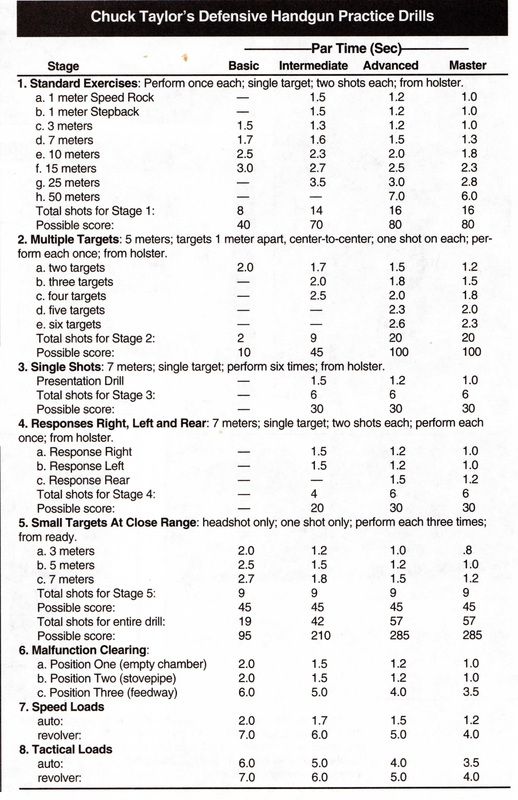One of the few trainers out there (still) with distinct standards is Chuck Taylor. Chuck teaches classes at 4 levels Basic, Intermediate, Advanced & Master. Each of these classes cumulates with a test that must be passed in order to receive a certificate. Those who achieve a score of 90% or higher receive a Distinguished Graduate certificate except for at the Master level where a 90% or higher is required to pass.
The following chart does not describe the individual tests at each level but the standards can be seen in each category.

To pass the Master level test you must start by scoring a minimum of 360 points out of a possible 400 on the shooting drills listed below. The test must be conducted by Chuck Taylor or an authorized ASAA instructor, firearms and holster must be concealable "street" equipment (no optical sights, compensators, speed rigs, etc.) and all ammunition must be full power with the .38 special the lowest power cartridge allowed. Shots are scored 5 points each for center hits, peripheral hits are 2 points for major calibers, 1 point for minor. The target to be used is the original buff/green Taylor Combat Target, with it's 5 point head zone of 4" x 3". All drills start with holstered gun, hands at sides. Times are by stop watch.
Once the shooting drills have been completed the candidate is tested on reloading and malfunction clearance drills as shown below. Failure to use ASAA methodology in performing the drills results in a procedural error and point loss.
Standard Exercises - Single target - 2 shots per drill, each drill performed once.
1 meter - 1.0 second (Speed Rock)
1 meter - 1.0 second (Step Back)
3 meters - 1.0 second
7 meters - 1.3 seconds
10 meters - 1.8 seconds
15 meters - 2.2 seconds
25 meters - 2.7 seconds
50 meters - 6.0 seconds
Presentation Evaluation - Single target @ 7 Meters - 1 shot per drill, drill performed five times.
7 meters - 1.0 second
Responses Left, Right & Rear - Single target - 1 shot per drill, each drill performed five times using ASAA methods
Response Left - 1.0 second
Response Right - 1.0 second
Response Rear - 1.2 seconds
Multiple Targets - Targets at 5 meters and spaced 1 meter apart
Two targets - 1.2 second
Three targets - 1.5 seconds
Four targets - 1.8 seconds
Small Targets at Close Range - head shots - 1 shot per drill
5 meters - 1.0 seconds - perform four times
7 meters - 1.2 seconds - perform five times
Ambidextrous Shooting - 3 targets at 7 meters and spaced 1 meter apart.
Using both hands, a candidate fires one round on each target, speed loads, transfers the weapon to the weak hand and re-engages weak hand only firing one round per target. Time limit is 6 seconds for self loaders, 8 seconds for revolvers.
Hostage Situation - Partial head shots - Target at 7 meters, one shot per drill performed 5 times with hostage holder to the left side of the hostage's head and 5 times on the right side. Time limit 1.2 seconds.
Target at Odd Angles - Targets at 7 meters and 60% obscured by cover, one shot per drill, perform 5 times with target to the left side of cover and 5 times to the right side of cover. Time limit 1.2 seconds.
After completing the above shooting test you still must perform each of the following weapon handling and malfunction (self loaders only) drills 5 times each. For each drill improperly performed or performed over the time limit, 5 points are deducted from your shooting score. 360 remains the minimum scored required to pass.
Speed Reloads - self loaders 1.5 seconds
Speed Reloads - revolvers 4.0 seconds
Tactical Reload - all weapons 4.0 seconds
Type 1 malfunction - 1.0 second
Type 2 malfunction - 1.0 second
Type 3 malfunction - 4.0 seconds
. Snarky and easily butt hurt. Favorite animal is the Cape Buffalo....likely indicative of a personality disorder.
. Snarky and easily butt hurt. Favorite animal is the Cape Buffalo....likely indicative of a personality disorder.